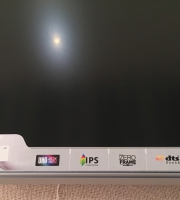
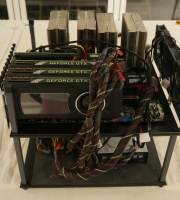
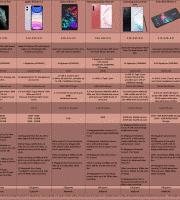
Ati’s latest flagship offering builds upon the success of its forerunner, the HD 5970 and is once again based around a dual GPU design. The formidable 5970 emerged in the winter of 2009 and in terms of the overall level of performance yielded by a single card, arguably retained the number one spot throughout the whole of 2010. Within this period at the top of the range, we saw the emergence of Nvidia’s GTX 480 and 580 cards along with a 2GB revision of ATi’s 5870, the slimmed down 6870 and finally, the former’s logical successor, the 6970. However, it was only at very high resolutions coupled with, in general, greater than 4xAA and recent visual enhancement techniques such as tessellation, that any of the aforementioned cards was able to match and in a comparatively small number of cases, surpass the records set by the 5970.
One of the principal reasons behind the 5970s Achilles heel was its relative lack of memory, 2GB in total but only 1GB allocated to each of its two GPUs. By comparison, both of Nvidas contenders boast only 1.5GB of memory but since they are single GPU cards, this memory does not need to be shared, giving them an effective 0.5 GB advantage in certain scenarios. The same applies to an even greater degree when comparing the 2GB editions of the 5870 and 6970 which are again, both single GPU cards benefitting from non-shared memory. Though memory has never been the most significant factor in determining the performance of a video card, with the increasing popularity of higher resolutions and keen investment in multiscreen configurations amongst enthusiasts, it is becoming important to ensure not just high, but smooth frame rates in the most demanding applications.
With the 6990, ATI has addressed this issue head on, each of its GPUs has been allocated double the amount of video memory making for a staggering total of 4 gigabytes of DDR5, a full gigabyte more than Nvidia’s recently released rival, the GTX 590. The design and specifications of the 6990 follow almost exactly the same pattern relative to the 6970 and 6950 as the 5970 did relative to the 5870 and 5850. The card consists of two Cayman XT GPUs, each with a full complement of 1536 stream processors exactly as found on the 6970, but with a conservatively clocked core and memory. The user then has the option via a combination of the card’s dual BIOS and ATI’s comprehensive driver tweaks, to clock the chips back up to and potentially beyond their native “single card” speed.
The table below shows how the spec of the 6990 compares to its six most recent forerunners.
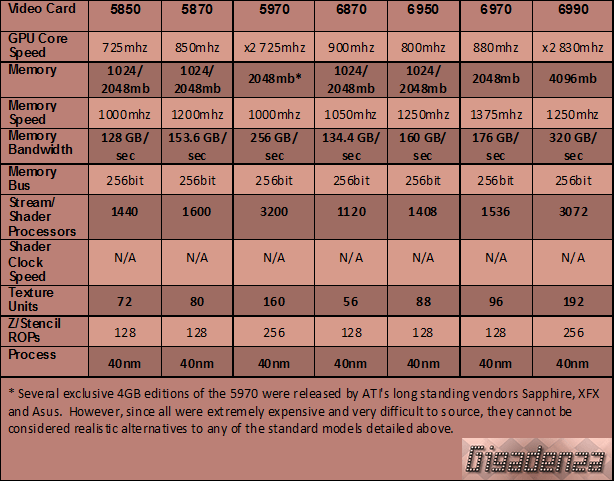
The 40mn design of the “Cayman” chip found on the 69XX series reflects that of the “Cypress” chip found on ATI’s previous generation of cards, though several key alterations have been made to the architecture to maximise efficiency in the way data is processed, reduce power consumption and achieve greater level of performance in geometry and tessellation, two areas where Nvidia has established a decisive lead. It is ATI’s claim that the 6970’s tessellation rate is roughly three times that of the 5870 which means the 6990 should enjoy a similar advantage over the 5970.
Moving on from the technical details to the physical hardware, let’s take a look at the HIS card, which does not elaborate on ATI’s reference design.
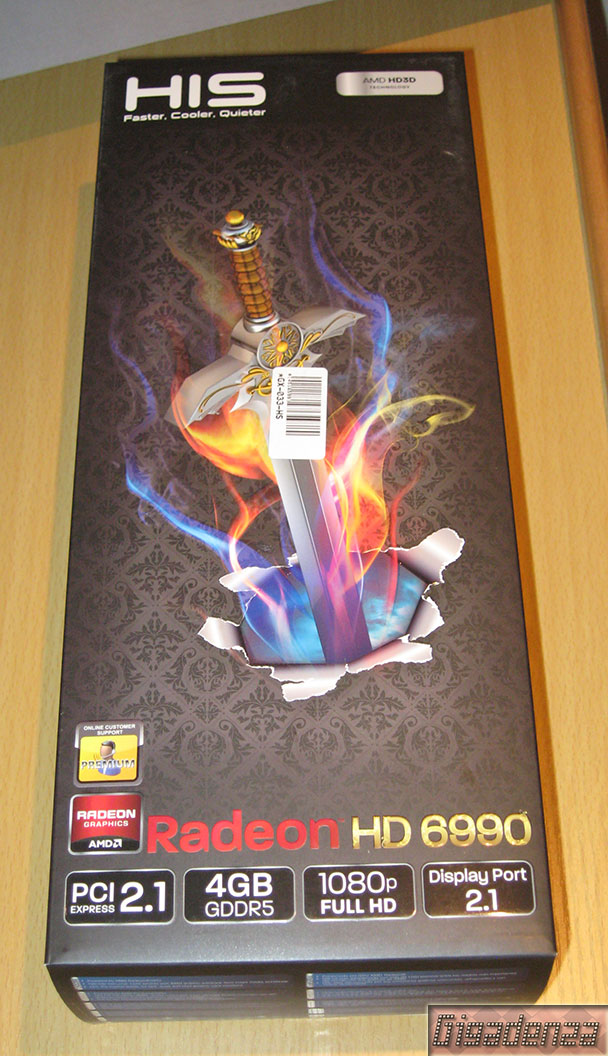
Outer packaging.
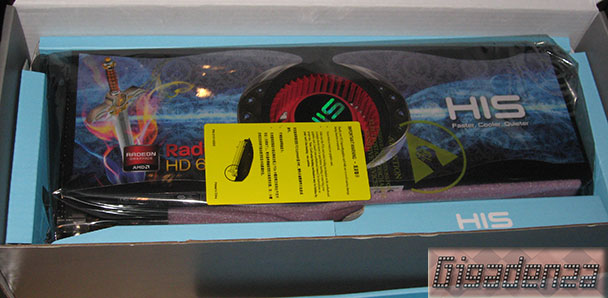
Inner Packaging.
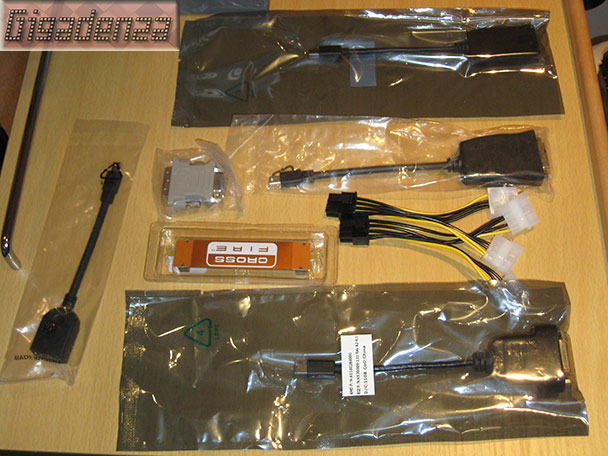
Accessories.
HIS has included a generous array of accessories with their 6990, eliminating the need for any further purchases in order to exploit the cards full potential…well…save for that of a cutting edge PC and three HD capable displays!
The bundle includes two mini display port to single-link DVI adaptors (one active and the other passive). A mini display port to standard display port adaptor. A mini display port to HDMI adaptor. A DVI to VGA adaptor. A crossfire bridge adaptor, this particular bridge cable is about 10cms in length, longer than the one supplied with the 5970, meaning those running crossfire setups will be able to install the cards with a gap of up to two slots between them. Since motherboard layouts vary significantly between manufacturers and can occasionally make it physically impossible to install such huge cards in certain slots, this is an important detail. Oh, and it also lends a little aid to cooling! Finally we have two molex to 8-pin PCI Express power adaptors which, when considering the 6990 sports a pair of 8-pin sockets rather than the six/eight combination we saw on its predecessor, is also most useful.
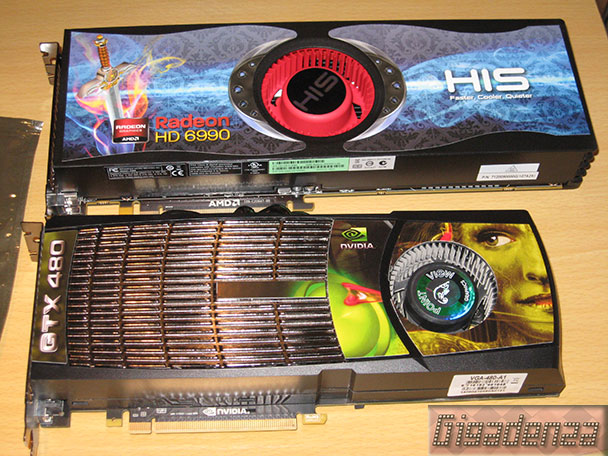
The card itself is almost exactly the same length as the 5970, just a shade over 30 cms but the re-deigned housing is not bevelled at the front, making it potentially even more of a squeeze to install. As can also be observed, the card’s fan has been located in the middle of the housing, ostensibly to ensure that both GPUs are the same distance away from it and hence, receive an equal amount of cooling.
This is a bold departure from the traditional design that both ATI and Nvidia have been using for several generations and though one can understand the logic behind it, may only be fully effective if the card is installed in cases with side intake fans, since the fan will now be further away from any intake fans at the front of a case and less able to benefit from the cool air they draw in. It may also “push” some of the hot air generated by the front GPU in the opposite direction to the airflow applied by most case fan configurations. Time and experience will prove whether or not this modifications is constructive.
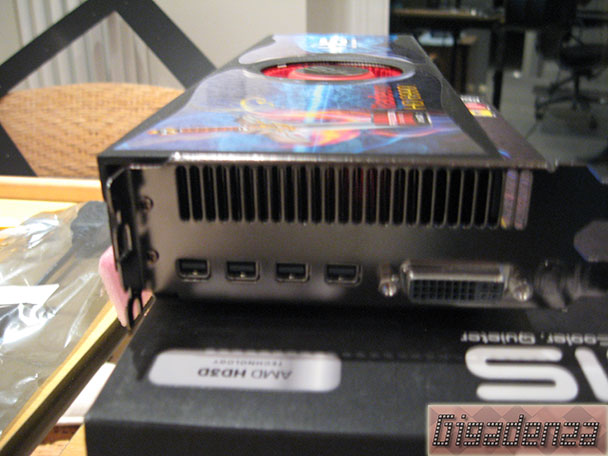
The card’s backplate has a large vented area to allow hot air to be exhausted as quickly as possible. Below that are four mini display ports and the usual dual link DV-I port.
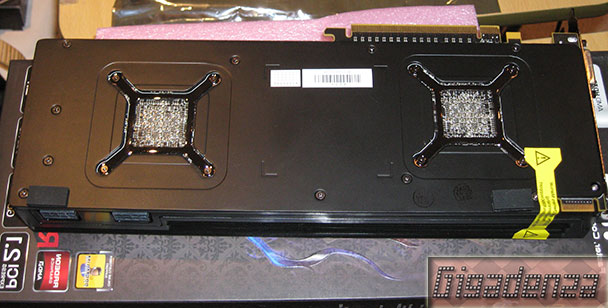
The rear of the card shows the position of its two GPUs, one on each side of the fan and as with the 5970, one horizontally aligned a little above the other. Note the yellow “warranty void sticker”, this is covering the dual BIOS switch which, if adjusted to “position 1”, will activate the card’s “OC mode” increasing the cores voltages from 1.12v to 1.175v and their speed from 830mhz to 880mhz. By introducing such an accessible hardware level overclicking facility, AMD clearly wishes to highlight the card’s potential to punch above its already colossal weight and many have rightly questioned their carrot and stick approach towards those who give into temptation. When pressed on the matter, they have allegedly stated that though there is no official warranty, they are confident that the cards will tolerate the extra demand. In a case where a customer’s card fails as a direct result of this feature being exploited – which would in itself be extremely hard to prove – it is difficult to imagine that any vendor with a half-decent RMA programme would simply turn a blind eye.
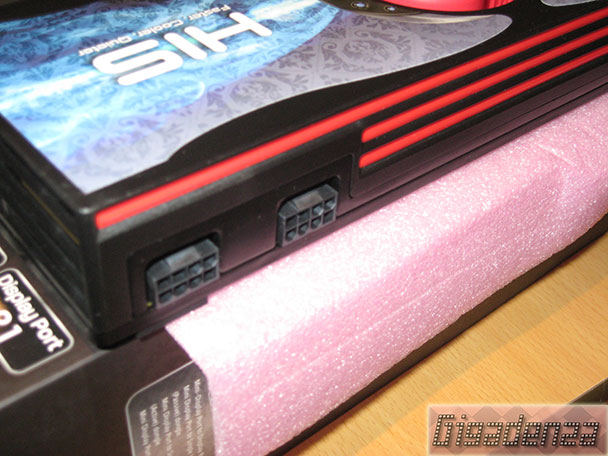
As mentioned earlier, the 6990 requires two 8pin PCI-Express connectors and AMD/ATI recommends no less than a 750 watt power supply to ensure stable operation. Theoretically, the maximum amount of power the card draws from its slot and both 8 pin connectors is 375 watts, 75 from the slot and 150 from each connector, which is its official default TDP (Thermal Design Power) rating. In practice however, specifically when running in overclocked mode, some reviews have estimated this figure to be as high as 500w. Presently, there is no accurate way to measure the power consumption of a video card separately from that of the total system but considering AMD’s official claim is 450 watts (in over clocked mode) and that this is what the card’s cooling system is rated to handle, a high quality PSU delivering 750 watts does seem a sensible minimum!
AMD has also implemented a new and adjustable power management system known as “powertune” which dynamically maintains the card’s core and memory speeds at their optimum levels in direct relation to its TDP and under extreme circumstances, prevents the card from exceeding it by reducing them. At first, this may sound like something of a copout but over the past two years or so, there have emerged several video card “stress testing” applications which place the GPU under far greater pressure than even the very latest games – two cases in point would be Furmark and OCCT – and it is specifically for these rare scenarios that the feature exists. For those who are still dubious, the card’s additional BIOS and drivers afford the ability to manually fine tune the TDP over a range of 40%, allowing a maximum in excess 450 watts. It is all but impossible to imagine a scenario that would necessitate as much power as this, let alone greater.
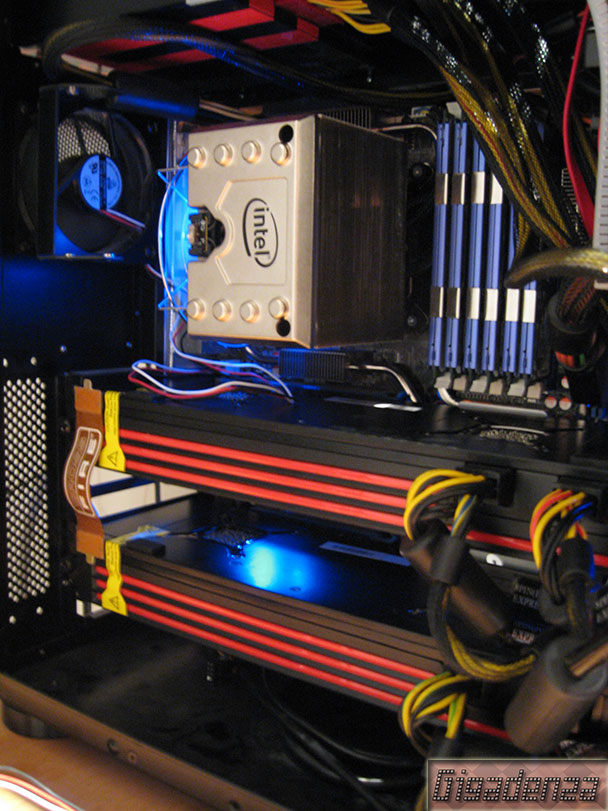
Two 6990 cards intalled in an Asus p6t7 Supercomputer motherboard.
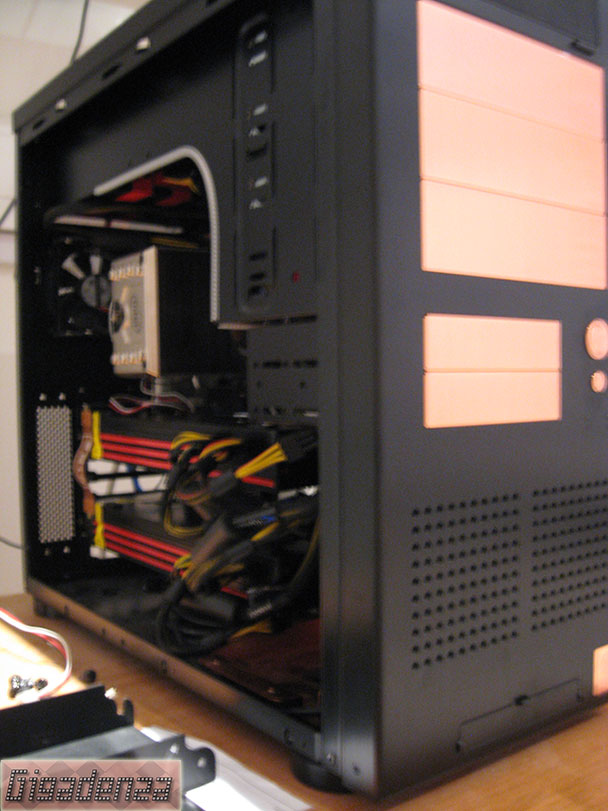
This last picture is a little blurred but it does demonstrate that a case based on a 10 year old design (a Lian Li PC-p60) is still capable of accommodating the latest hardware, the hard drive cage had to be removed though aside from this minor sacrifice, the cards fitted comfortably!